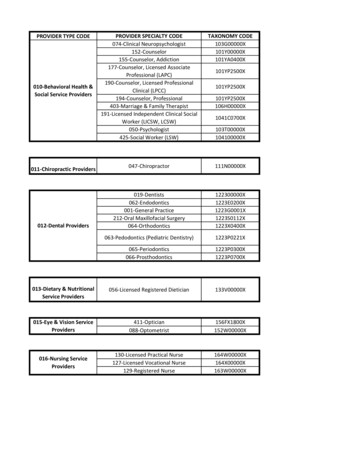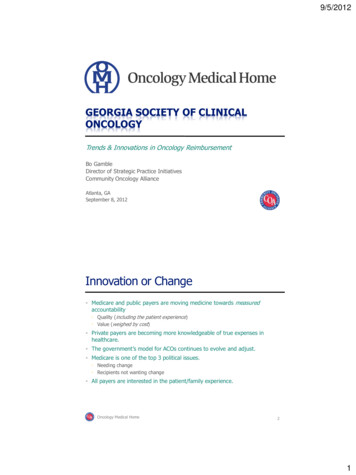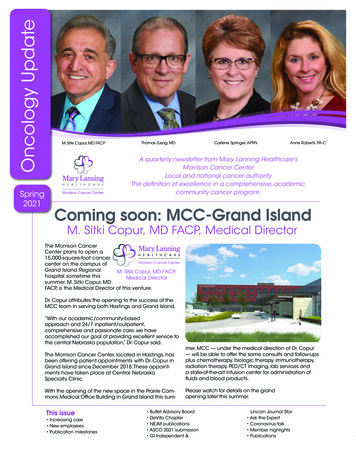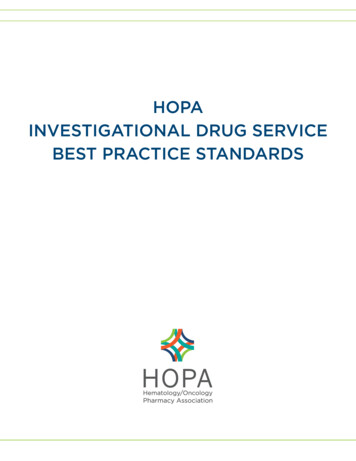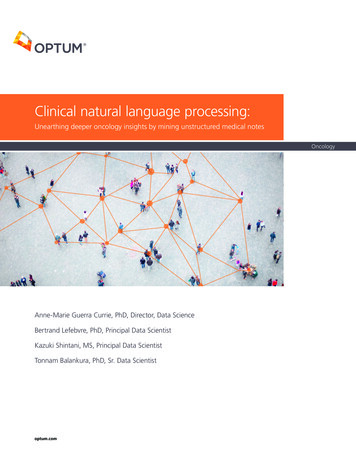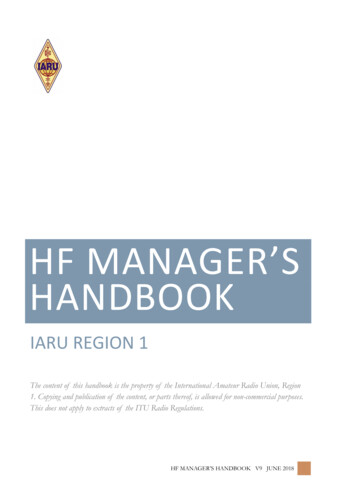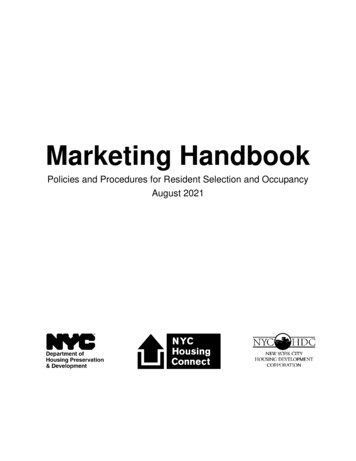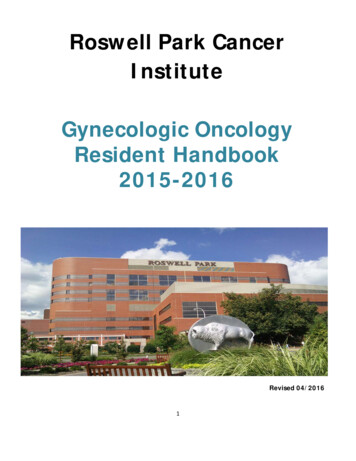
Transcription
Roswell Park CancerInstituteGynecologic OncologyResident Handbook2015-2016Revised 04/20161
ACKNOWLEDGEMENTSThis handbook would not have been possible withoutthe contributions, inspirations, corrections andsuggestions of many individuals, including:Bonnie BlumPeter FrederickKassondra GrzankowskiShashi LeleJoanne MastersonKunle OdunsiMichelle PelletierGrazyna RiebandtJames Brian SzenderEmese Zsiros2
“There are known knowns. These are things we know that we know. There are known unknowns.That is to say, there are things that we know we don't know. But there are also unknownunknowns. There are things we don't know we don't know”.Donald RumsfeldGynecologic Oncology HandbookRoswell Park Cancer InstituteWelcome to the Gynecologic Oncology service at Roswell Park Cancer Institute. Our goal is toprovide first-rate, compassionate care for every patient. To accomplish this we must work as ateam which includes physicians, nurses, pharmacists and support staff. Residents are a vital partof this team. To ensure the best experience for all involved everyone must know their role andexpectations. The purpose of this handbook is to not only detail those expectations, but to provideyou with some of the tools to attain them. Our hope is that in doing so we can allow for aneducational and enjoyable rotation.3
TABLE OF CONTENTSI.PGY-2 & PGY-3 RESIDENT EDUCATIONAL OBJECTIVESIII.CONTACT INFORMATION/PHONE NUMBERSII.IV.V.RESIDENT RESPONSIBILITIESA.Welcome Letter from the FellowsA.Appendix 1-Discharge SummaryNOTE FORMATSB.C.VII.A.Uterine CancerB.Ovarian CancerE.Vaginal CancerD.Cervical CancerVulvar CancerPRE-INVASIVE LESIONSCRITICAL CARE MEDICINEA.Sepsis and Systemic Inflammatory Response SyndromeD.Acute tubular necrosisB.C.E.VIII.Appendix 3-Structured Clinical NoteDISEASE SITEC.VI.Appendix 2-Complicated PatientsMyocardial infarctionVenous thromboembolismInfections (community-acquired pneumonia, nosocomial pneumonia, UTI)1.2.C. DifficileNeutropenic corubicin HCL Liposome4
Y EXTRAVASATIONX.MISCELLANEOUSXI.“PIMP” QUESTIONSXII.A.B.Intraoperative ureteral injuryCVP removalBLS ALGORITHM5
PGY-2 & PGY-3 RESIDENT EDUCATIONAL OJECTIVESThe educational objectives of the RPCI Gynecologic Oncology Resident Program include thefollowing:I. Educational purpose-PGY-2-3 residents are trained to manage gynecologic nonmalignant andmalignant tumors. They perform preoperative evaluations and major and minor surgicalprocedures. They manage uncomplicated and complicated postoperative and critical care patients.II. Goals and Objectives*By the end of the rotation, the resident will be able to:1. Medical knowledge-Basic sciences-Describe indications for screening for BRCA1 and BRCA2-Describe the anatomy of the internal and external pelvic organs-Describe the vasculature and lymphatics to the internal and external pelvic organs-Describe the relationship between the bladder, ureter, bowels and uterus-Describe the histology of gynecologic malignancies-Describe chemotherapeutic agents used for gynecologic malignancies-Describe side effects of chemotherapeutic agents used for gynecologic malignancies2. Patient care-Perform comprehensive history and physical on patients with gynecologic malignancies-Order and interpret appropriate diagnostic test for gynecologic malignancies-Manage postoperative complications in patients with gynecologic malignancies-Manage critical patients with gynecologic malignancies-Describe the indications for radiation and chemotherapy in patients with gyn malignancies-Describe the complications of radiation and chemotherapy-Describe the principles of palliative care-Describe the principles of pain management3. Practice-based learning-Maintain gynecologic oncology case mean numbers at the national average-Attend grand rounds, chapter reviews and journal clubs-Describe statistical test (Chi-square and t-test)-Use information technology (PubMed literature, Cochrane Database)6
4. Communication-Communicate effectively with patients and family members-Sustain a therapeutically sound relationship with patients and family members-Maintain comprehensive, timely and legible medical records-Present clear concise clinical presentations to attendings, residents and medical students5. Professionalism-Demonstrate respect for physicians, referring physicians, residents, medical students, nursingstaff and clerical staff.-Demonstrate responsibility for the care of all patients on labor and delivery-Demonstrate accountability for all clinical decisions-Advocate for all patients-Demonstrate ability to teach medical students-Demonstrate ability to interact with hospital staff6. Systems-based practice-Demonstrate interest in understanding the local health care system structure-Demonstrate an understanding of the roles of the health care team members-Effectively use ancillary service personnelIII. Types of clinical encountersThe PGY-2-3 resident will manage the following conditions:-Describe the clinical presentation of VIN and VAIN-Perform vulvar biopsies-Describe the differential diagnosis of vulvar carcinoma-Describe the FIGO staging of vulvar cancer-Counsel a patient about treatment options including surgery, radiation and chemotherapy-Describe the prognosis of vulvar cancer-Describe the FIGO staging, treatment and prognosis of vaginal cancer-Describe the classification of cervical dysplasia-Describe the treatment options for cervical dysplasia-Describe the FIGO staging, treatment and prognosis of vaginal cancer-Describe the classification and management of endometrial hyperplasia-Describe the FIGO staging, treatment and prognosis of endometrial cancer-Describe the classification and management of ovarian tumors-Describe screening methods to identify patients at risk of hereditary ovarian cancer-Describe the histology of ovarian cancers-Describe the FIGO staging, treatment and prognosis of ovarian cancer7
-Diagnose and manage hydatidiform mole-Describe the diagnostic approach to gestational trophoblastic disease (GTD)-Classify metastatic GTD in low and high risk-Counsel patients regarding treatment, prognosis and recurrenceThe PGY-2 resident must understand and the PGY-3 must master the following procedures:-Abdominal hysterectomy-Staging laparotomy-Washings, exploration and omentectomy-Suction curettage of molar pregnancy-Cervical conization (LEEP and cold knife cone)-First assistant for robotic procedures (port placement, docking, uterine manipulation).The PGY-2-3 resident must understand the following procedures:-Radical hysterectomy-Lymph node dissection-Radical vulvectomy-Vaginal reconstruction-Radical vulvectomy-Exenteration-Bowel resectionIV. Rotation structureRotation Sites:Roswell Park Cancer Center -2 modules-0630 AM rounds with chief fellows (daily)-0800 AM rounds with gyn-oncology attending (daily)-The PGY-2-3 resident remains on the unit for 10-12 hours.V. Resident supervision-All gyn-oncology procedures performed by the PGY-2-3 resident on patients are performed underthe supervising faculty member.VI. Method of evaluation-The PGY-2-3 resident receives daily feedback from fellows and attending faculty physicians-Faculty physician evaluations are performed at the end of the rotation-Global evaluations are performed semi-annually8
VII. Reading list1. Clinical Gynecologic Oncology, DiSaia, 7th Ed. (May 2007)2. Practical Gynecologic Oncology, Berek, 5th Ed. (2009)3. Atlas of Procedures in Gynecologic Oncology, Levine, 2nd Ed. (2007)4. Principles and Practice of Gynecologic Oncology, Barakat, 6th Ed. (2013)5. ACOG Compendium 20159
RESIDENT RESPONSIBILITIESPrior to Day #1 It has been arranged that residents will check in with the Department of Education Affairs, RSCBuilding (4th Floor, Room 408) for registration, attend the EMR training/ orientation toelectronic medical records, obtaining passwords, dictation code, etc., and obtain an ID badgefrom The Parking and Transportation office (ground floor of the parking ramp, hours are 7am5pm) the week prior to their start date to allow for maximum participation on their 1st day.Day #1 Please coordinate with the clinical fellows regarding where and when to report on Mondaymorning. Typically on the 1st and 3rd Monday of the month there is GYN Didactic Lecture heldin the GYN Clinic Conference Room, Main Hospital, 2nd Floor, Room H2-128 at 6:45am-7:45amwith rounds to follow. On opposite Monday’s you should report to the floor for rounds.Parking: At this time, there is no reduced rate/dedicated parking for rotating residents. Theparking ramp may be used on a daily basis. There is also an open lot next to the ramp that isprivately owned, which may be available during the rotation.Resident Responsibilities Round on inpatientsMaintain the list (Please contact Michelle Pelletier for access to the GYN Fellows Drive)Operate in ORSee patients in clinicProfessional dress is encouragedo Women – Dress slacks or skirto Men – Shirt and tieResident: Give one PowerPoint presentation-topic to be discussed first week and scheduledwith Michelle Pelletier.Dictate discharge summariesDischarge paperworkDischarge PrescriptionsResidents do not take any home calls on this rotationDaily Responsibilities Patients should be seen and have notes written by 6:45am each morning (time decided on theday prior depending on the patient load)10
Each resident will be responsible for a maximum of 5 inpatients in the morning. All ICU orIMCU patients should be seen by a fellow.Update the list (An electronic list is maintained and printed each morning. It provides a short“bio” of each patient, i.e. age, reason for admission, operation, medical co-morbidities, relevantdiagnostic studies, significant in-hospital developments, etc. This list acts as a quick referenceas well as allows for continuity of care as residents and fellows covering the service mayperiodically change.)A fellow and/or resident should be present and scrubbed for every case that goes to the OR. Ifthere is more than one resident on service then the time spent covering the clinic and OR willbe evenly divided amongst them.Follow-up on labs, radiology studies, call consults, etc.The first resident either out of the OR or out of clinic should go to the floor to pre-round andprepare for evening rounds; and report findings to the fellow. Find out vitals and I/O’s for theday, know results of studies and labs, know what consultants recommended, talk with thepatients to see how they are doing.Notes do not need to be written on evening rounds.During rounds, the fellow/ resident should pay attention and write down any neworders/plans.After rounds are over, all orders decided on rounds must be ordered.Patients that are going home will require the following items:o A dictated discharge summary (Note: Avoid writing the novel called “Discharge Summary.”Brevity is the key. See Appendix 1 for discharge summary template. Make sure summaryassigned to attending primarily managing patient’s care. )o Discharge paperworko Prescriptions for analgesia, constipation, etc.* (post op lovenox for high risk patients total28 days and sent to tube #36 Anita-Social Work). See Appendix 2 for high-risk patients.o Schedule a follow-up appointment. Make sure you know where the patient will be followingup (Buffalo campus, College Park, Niagara Falls, Jamestown)o Remove all drains, central lines, etc. when applicable—ideally the day before anticipateddischarge unless told otherwise.Afternoon rounds: provide update of any patient issues that have come up during the day, e.g.results of any testing or imaging studies, any change in status?, etc.Weekend Responsibilities There is always a fellow and attending on call.If two residents are on service, one resident will be responsible for rounding Saturday andSunday, with weekend responsibilities to alternate between residents.11
If one resident is on service at a time, he/she is only responsible for rounding on SaturdaymorningClinic There are patients scheduled in clinic every weekday (see schedule)Clinic phone number: 845-5855Nurses will assess patients initially (vital signs, reason for visit, etc.) prior to putting them in aroomPatients should be seen in the order in which they were placed in a room.Patient’s last note will be placed in the chart as well as their medication list, chemotherapysheet (if applicable); (any additional dictated reports, pathology reports, labs, etc. can beaccessed in EMR)After seeing a patient, there are two sheets that need to be filled out (F10 and billing sheet).Most new patients are level 5. Most chemo and return patients are level 4. If it is a discussiononly visit, be sure to document it as such, with the amount of time spent in discussion, “withmore than half that time spent in counselling and coordination of care.”After completing the documentation, take the chart to the front desk (unless it is achemotherapy patient; chemotherapy charts should be given to one of the chemotherapyproviders.Clinic Note Documentation: See Appendix 3 for instructions.Operating Room The Operating Rooms are located on the 3rd floorBefore being taken to the OR, patients are assessed in the pre-operative holding area (adjacentto the OR). After updating their H&P and undergoing pre-operative assessment and marking,patients are then wheeled back to the OR by the anesthesia team.12
ORCLINICMondayZsirosClinic/OR Schedule (as of April 2016)(AM):FrederickNiagaraFalls lternatingweeksBMG :AkersJamestown (4thFriday of themonth):FrederickNote: Additional Activities: Fellow didactic lectures on Mondays at 6.45am and/or Fridays at 1:00pm. 1st and 3rd Wednesday @ 7:30am Multidisciplinary Tumor Board Every other Month on Tuesday @ 8:00am Familial Ovarian Cancer Registry meetings Tuesdays mornings at 8:45am weekly research meeting in the laboratory for lab fellows Every other month on Friday afternoons Morbidity and Mortality Conference Quarterly Surgical Services Quality Improvement meetings. Daily morning and evening rounds. Every Tuesday afternoon @ 4:00pm weekly chemotherapy review and planned surgicalcase review GYN Molecular Tumor Board 4th Tuesday of the month @ 4:00pm13
PresentationPGY-3 Residents on service are required to prepare and present a talk on a clinically relevanttopic. The attendings and fellows can guide you in choosing a topic.Past topics have included: Cancer in pregnancyGestational trophoblastic diseaseGerm cell tumorsGenetic predispositions to gynecologic malignanciesUreteral injuries in gynecologic surgeryMolar pregnancyPost-operative bowel complicationsNecrotizing fasciitisIntraperitoneal chemotherapyBorderline ovarian tumorsVenous thromboembolismThe presentation should last approximately 30 minutes. The use of primary sources with an indepth analysis of available literature is encouraged.Attendings and Fellows are available to assist with presentation suggestions. All topics shouldreceive final approval by Dr. Frederick.A projector will be provided as well as a laptop computer to facilitate a PowerPoint presentation.Contact Michelle Pelletier at: Michelle.Pelletier@roswellpark.org with your topic and she will putyou on the schedule to present near the end of your rotation.An electronic copy of the presentation should be forwarded to Michelle Pelletier at:Michelle.Pelletier@roswellpark.org.Conferences Every other Wednesday morning at 7:30 am there is Multidisciplinary Tumor Board where wereview the pathology from the cases the weeks prior. It is coordinated by Dr. John Kazsnicka.Residents are excused if they have a conflicting lecture at CHOB, but expected to attendotherwise.Every Tuesday afternoon (04:00PM) we have Gyn Conference in which we review the ORschedule for the upcoming week, discuss chemotherapy patients, and have a learningtopic/presentation (given by a fellow, resident, pharmacist, or guest speaker)14
Order EntryRoswell Park Cancer Institute utilizes a computerized physician order entry system. While thishas streamlined order entry please do not let it be a substitute for communication with thenursing staff about the plan of care. The Gynecologic Oncology service has several order setsfor use. Those orders may be access as below:1.2.3.4.5.6.7.8.go to Roswell Park Cancer Institute internal web pageclick on “EMR Citrix” on left side of web pageclick on “EMR” iconclick on patient for whom orders are to be writtenclick on icon of clipboard with pen (upper left-hand corner of web page)type in the word “gyn”hit “enter” keyselect desired order setCommon Sense Stuff1. Always have a chaperone when doing a pelvic examination.2. Ask if you don’t know something.3. The chemo nurse is an excellent resource. (Remember to give her chemo charts whendone.)4. When in doubt examine the patient.5. Know what room the patients are in.15
Welcome to Roswell from the FellowsWe are all very excited to have you on our team! Prior to your start date we would like tosummarize some of our expectations to ensure we maximize your clinical experience and that youhave a great time at Roswell.We are a team and we expect everyone to help each other out on the floor, in the OR, and in clinic.This just makes for a more enjoyable work environment. If there are things that we are doing ornot doing that you would like to see changed you please talk to us immediately in person, by email,or by phone (Kassondra 716-574-0571; Rachel 201-960-8148; Brian: 210-287-0836; Paul: 706248-0797). As we are taking care of very sick and complex patients, we need to know everythingabout our patients and you are an essential part of our team looking after them and updating all ofus. Your work and clinical judgement is very valuable to us, but we are also here to help you andteach you on how to manage them. If you think that you are in danger of violating work hours weneed to be notified before anyone else, so we can fix your schedule and make sure you don’tviolate the work-hour rules.Rounds in the AM:Clinical notes need to be done prior to table rounds; however plans may change after we meet.Make sure you update your note after our discussion and rounding with the attending of the day,so before the attending signs off on your note the plan stated in your document reflects the correctassessment/plan for that day.We will round as a team between 0615 and 0640 depending on the number of patients in house,when faculty are rounding, and other morning responsibilities, we’ll meet in the conference roomon 7E.Please make sure that notes are assigned to the attending making rounds each morning, not theadmitting attending. If people are away from the hospital there will be a different personrounding on their days. Please check with us if you have questions. We can also show you how tochange the assignment if the appropriate attending is not initially chosen for your note. Thegeneral rule of thumb is as follows:Monday: Dr. ZsirosTuesday: Dr. LeleWednesday: Dr. OdunsiThursday: Dr. FrederickFriday: Dr. AkersWeekends will be at the direction of the fellow/attending on call. The on call schedule is availableon I2.16
Clinic:We expect everyone to help see patients, during fellowship our priority is working up newpatients as well as managing patients undergoing chemotherapy, thus we will preferentially seenew cancer patients (orange charts) and chemotherapy patients (purple charts).You should preferentially see follow-up patients (especially post-ops whose surgeries you wereinvolved with) and surveillance exams. If there are new patient referrals with abnormal Papsrequiring colposcopy or conization, they are also good patients for you to see.Every patient needs to be checked out with an attending. You cannot send home any patientswithout an attending seeing and examining them!Providing high quality care and seeing patients in an efficient manner and reducing our clinic waittime are our top priority. This often means you have limited time to document between patients,especially as the clinic gets busy. In this case please start a blank note for them in their chart – asevery patient need to have a note started on the day when they were seen – save it as incompleteand finish it at the end of clinic. It is unacceptable to spend time with documentation whenpatients are waiting to be seen.You clinic notes need to be complete – including PMHx, PShx, Familyhx and Socialhx as well –every single time you see a patient. Please have your notes ready to be signed by the attending thelatest 8 am the next morning.OR:Residents are expected to be on time for all OR cases. If you are late you may not be allowed toparticipate. First case starts as scheduled and you should arrive at least 15 mins before the startof the case to interview the patient and ensure pre-op paperwork is complete. For subsequentcases it is the resident’s responsibility to monitor room turnover to know when the next case is tostart.If you pre-op a case we will try to let you come to the OR that day.We are responsible for keeping track of all post-operative morbidity and mortality. We shouldalready be aware of all fevers, surgical site infections, unexpected ICU admissions, or anythingelse; however, if you are aware of someone presenting and being discharged over the weekendplease make sure it is brought to our attention. Criteria for and documentation of complications isalso important as we are a NSQIP institution. Every other month morbidity and mortality cases arepresented at conference.We will write post-op orders on patients, preferably with you so that you can learn the way thatwe think about post-operative pain control, fluid management, and monitoring labs.You will be responsible for writing the MD Brief Operative Note, this document is pretty straightforward in what it asks. It is very important that this is filled out correctly and on every patient17
because operative dictations will often take a day or two to arrive into the system and the fellowon call will need to know the pertinent information for the patient if they receive any pages. Thesenotes should be done after every case and not just at the end of the day, if one of us is in clinic andgetting paged about a patient while the other of us is in surgery, it is helpful to at least know whatsurgery the patient had and what the EBL was.If there are multiple residents on service we will leave it to you to divide up the cases between oneanother. It is important for you to try and work with all attendings both in the clinic and theoperating room throughout your rotation. If you have concerns about case distribution, pleasespeak to one or both of us and we will try to help make sure things are fair.Rounds in the PM:We will typically round after all OR cases are done and clinic patients are seen; howeversometimes this will change based on schedules.After rounds at Roswell are completed sometimes there are patients that need to be seen at BGH.Typically the fellows and attendings will head to BGH allowing you time to update the list and getorders ready for the AM. This is also a good time to call consults before other services have gonehome for the day.We will discuss what labs are required for individual patients while we are making our rounds,please take notes and make sure labs are ordered as AM LAB when you put them in for the nextday.After labs are ordered for the next day, this is a good time to get anticipated discharges for thenext day squared away. Usually this involves cleaning up the electronic medicalrecord/prescription writer, making sure that a Lovenox prescription or any other pre-authprescription has been sent to Anita if appropriate (this should usually be done on post-op day #0,please ask if you have questions), and writing prescriptions for pain medications, stool softeners,and other home care needs.Documentation:Documentation is extremely important when taking care of our patients for a number of reasons:#1 it helps the next person who sees the patient know what was discussed and what the plan was,if you have questions please ask; #2 it helps the referring practitioner know about the status oftheir patient; #3 for billing purposes if it isn’t documented it didn’t happen.We have strict guidelines on clinical documentation, please follow that every single time for bothinpatient and outpatient notes. Please see the attached document on how to write a structurednote in EMR and follow that template for every single patient.Information including diagnosis, stage, and list of prior therapies, including starting and endingdates should also be included on the daily checkout list. This will help on rounds when there are18
questions about the patient’s overall disease status and will help avoid losing the forest for thetrees.Discharge summaries should be assigned to the patient’s clinic attending, not the attending thatmade rounds on the day of discharge. Sometimes the EMR has an attending listed as the admittingattending but the clinic attending who the patient belongs to is someone different.Questions, Questions, Questions. We are a team and expect lots of questions, especially as you arestarting out. When you have questions please ask, we are going to have a great rotation together!!End of Rotation Presentation:At the conclusion of your rotation, typically the last Tuesday of your rotation you will be expectedto give a presentation. Discuss your topic choice with Dr. Frederick and receive his approval.Once you have received his approval please send your topic to michelle.pelletier@roswellpark.organd she will put you on the schedule. A copy of your presentation should also be saved on thefellows drive under the folder titled “Resident Papers and Lectures.”Thanks,Kassy and Rachel2015-2016 GYN Clinical FellowsIf you have additional questions, problems or concerns please contact the one who keeps us inline:GYN Clinic/Fellowship OfficeMichelle PelletierFellowship CoordinatorPhone 716-845-349719
CONTACT INFORMATION/PHONE NUMBERSUse the I2 on call calendar to text page or search by name in I2 and text page Roswell Park Cancer Institute (operator/main number): 716-845-2300To page or call someone: Dial “0”; follow prompts for ‘call’ or ‘page’ or page them from I2Gyn Clinic (front desk): 716-845-5855(nurses’ desk): 716-845-57537 East(Front Desk): x3590 (716-845-3590)Operating Room: x226X (X room number)Dr. Lele: office phone: x1330Dr. Odunsi: office phone: x8455Dr. Akers: office phone: x8337Dr. Frederick: office phone: x1694Dr. Zsiros: office phone: x7855Bonnie Blum (Pharmacist): Office phone: x3208Deanna Phoenix (Pharmacist): GYN Office phone: x8567Sharon Jankowski (chemotherapy nurse): x1420Karen Larkin (Nurse Practitioner): x8428Kim Ferrucci (Nurse Practitioner): x8365Margaret Duffy (Physician Assistant):x3026Anita Alfieri (Case Manager): phone: x4975Rachel Korman (Social Worker): direct line: x8486; office number: x8022; pager: 0767Michelle Pelletier (Fellowship Coordinator & Drs. Lele, Akers, Frederick, and Zsiros’ assistant):x5776 x3497Ashley Sedelmeyer (Dr. Odunsi’s assistant): x8376Odunsi Lab: x4502Microbiology lab: x3267IT Helpdesk: x8465Health Information Training (EMR questions): x347220
APPENDIX 1-Discharge SummaryDischarge SummaryDate of admit:Date of discharge:Service:Attending:Admit diagnosis: (e.g. FIGO Grade 1 endometrial cancer)Discharge diagnosis: (e.g. Clinical stage IA endometrial cancer on frozen section)Brief HPI: (Ms. Jones is a 65-year-old female with a medical history significant for morbid obesity(BMI 52) and Type 2 DM who presented with postmenopausal bleeding and was confirmed to haveendometrial cancer.Procedures/Operations:Consultations:Brief description of hospital course: (e.g.Ms. Jones underwent the above procedure withoutcomplications. Please refer to op-note for full details. Postoperatively, she was transferred to thefloor. On POD#1, she was tolerating PO with adequate pain control and was noted to meet alldischarge milestones. She was afebrile with stable vitals throughout her hospital stay.Discharge condition:Discharged to: (home, rehab, hospice, etc.)Discharge medications:Follow-up plan:(make sure to list referring physicians to send copy of discharge summary to)APPENDIX 2-Difficult PatientsIndications for prolonged anticoagulation (i.e. home prophylactic Lovenox) Any laparotomy with a cancer diagnosis Any robotic or laparoscopic hysterectomy with a cancer diagnosis and BMI 40 Patients with borderline ovarian tumor or endometrial hyperplasia are on a case-by-casebasis per risk factors and attending discretion In general, patients with current or recent thrombo-embolic disease should resumetherapeutic anticoagulation (warfarin may require Lovenox bridge) There may be exceptions to above guidelines depending on patient’s risk for bleeding21
APPENDIX 3-Structured Notes in Clinic Please use the MD H&P/Clinic Note for every single visit.Under the first tab “Reason for visit” please ONLY fill out two things:o -Select the Type of visit (new, return, post-op etc.)o -Enter the Chief Complaint (one max two words) – it is a MUST for billing for everypatientPlease do not use the Outpatient Statement or Current Therapy tab – it is redundant, willmake a note too long and hard to read and this will be in the HPIHistory of Present Ilness : Please state the patient age, diagnosis and why she is here.If she is getting chemotherapy please type the number of cycle and the dose (ex: Cycle 5Carboplatin AUC 5 Taxol 175 mg/m2 every 21 days). If on chemotherapy please commenton any Delays and Toxicities (ex: Cycle #4 de
Gynecologic Oncology Handbook . Roswell Park Cancer Institute . Welcome to the Gynecologic Oncology service at Roswell Park Cancer Institute. Our goal is to provide first-rate, compassionate care for every patient. To accomplish this we must work as a team which includes physicians, nurses,
